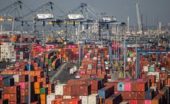Molly Minturn - My family is heartbroken to share that my father died in surgery on Monday, Feb. 10. It…
Japan 2011-2012
Written by Diana Thebaud Nicholson // July 13, 2012 // Economy, Geopolitics // Comments Off on Japan 2011-2012
China, Japan, Taiwan and the East China Sea
(The Diplomat) Although the sovereignty dispute between China, Japan and Taiwan over the Senkaku/Diaoyutai Islands in the East China Sea has always had its military component, from the 1970s onwards the three sides generally refrained from engaging in behavior that risked exacerbating tensions to the point where armed clashes could occur.
Recent developments, however, indicate that this self-restraint might be over, and that the conflict may be about to enter a new — and possibly far more perilous — phase.
2011
3 November
Japan, the Persian Gulf and Energy
(Stratfor Analysis) Over the past week, everything seemed to converge on energy. The unrest in the Persian Gulf raised the specter of the disruption of oil supplies to the rest of the world, and an earthquake in Japan knocked out a string of nuclear reactors with potentially devastating effect. Japan depends on nuclear energy and it depends on the Persian Gulf, which is where it gets most of its oil. It was, therefore, a profoundly bad week for Japan, not only because of the extensive damage and human suffering but also because Japan was being shown that it can’t readily escape the realities of geography.
First, the earthquake and the resulting damage to several of Japan’s nuclear reactors created a long-term regional energy shortage in Japan that, along with the other damage caused by the earthquake, would certainly affect the economy. But the events in the Persian Gulf also raised the 1973 nightmare scenario for the Japanese. Depending how events evolved, the Japanese pipeline from the Persian Gulf could be threatened in a way that it had not been since 1973. Combined with the failure of several nuclear reactors, the Japanese economy is at risk. …
It is not yet clear how devastating the nuclear-reactor damage will prove to be, but the situation appears to be worsening. What is clear is that the potential crisis in the Persian Gulf, the loss of nuclear reactors and the rising radiation levels will undermine the confidence of the Japanese. Beyond the human toll, these reactors were Japan’s hedge against an unpredictable world. They gave it control of a substantial amount of its energy production. Even if the Japanese still had to import coal and oil, there at least a part of their energy structure was largely under their own control and secure. Japan’s nuclear power sector seemed invulnerable, which no other part of its energy infrastructure was. For Japan, a country that went to war with the United States over energy in 1941 and was devastated as a result, this was no small thing. Japan had a safety net.
The safety net was psychological as much as anything. The destruction of a series of nuclear reactors not only creates energy shortages and fear of radiation; it also drives home the profound and very real vulnerability underlying all of Japan’s success. Japan does not control the source of its oil, it does not control the sea lanes over which coal and other minerals travel, and it cannot be certain that its nuclear reactors will not suddenly be destroyed. To the extent that economics and politics are psychological, this is a huge blow. Japan lives in constant danger, both from nature and from geopolitics. What the earthquake drove home was just how profound and how dangerous Japan’s world is. (14 March 2011)
Damaged Japan Nuclear Reactor May Still Be Active
(WSJ) Nuclear fission by-products have been detected at one of the reactors at the Fukushima Daiichi nuclear power plant, the government said Wednesday, raising the possibility that some parts of the melted core may still be active. … But agency officials said that it was too soon to say whether the finding represented a major concern. They said there have been no abnormalities detected in the temperature or pressure of the reactor, which has recently cooled down sharply.
23 May
Leak From Japan Reactor 100 Times More Than Permitted
(Reuters/Planet Ark) A water leak from Japan’s tsunami-crippled nuclear power station earlier this month resulted in about 100 times the permitted level of radioactive material flowing into the sea, operator Tokyo Electric Power Co said Saturday.
13 April
Japan’s government downgrades its outlook for growth
(BBC) The Japanese government has downgraded its assessment of the economy in the wake of the devastation caused by last month’s earthquake and tsunami. It said key areas of the economy would suffer, including industrial production and exports
12 April
Japan says nuclear crisis stabilizing, time to rebuild
(Reuters) – Japan’s nuclear crisis is slowly stabilizing and the country must now focus on repairing the damage wrought by the devastating earthquake and tsunami that struck the northeast coast a month ago, Prime Minister Naoto Kan said.
He was speaking shortly after new data showed more radiation leaked from the crippled Fukushima Daiichi nuclear power plant in the early days of the crisis than first thought.
That new information put Japan’s nuclear calamity in the same category as the world’s worst nuclear disaster, Chernobyl, officials said, but the upgrade in its severity rating to the highest level on a globally recognized scale did not mean the situation had suddenly become more critical.
5 April
Japan stops radioactive leaks into sea from crippled nuclear plant
(Reuters) – Operator of Japan’s crippled Fukushima Daiichi nuclear complex said on Wednesday it had stopped leaks of contaminated water with high levels of radiation into the ocean.
29 March
Japan’s nuclear crisis: In hot water
(The Economist) FRUSTRATION is mounting once again about the dangers emerging from the stricken Fukushima Dai-ichi nuclear power plant. This is partly due to new evidence: that there may have been a partial melting of nuclear fuel within the reactors’ protective structures and that radiation, including small doses of plutonium, has since leaked into the surrounding area. But fanning this anxiety is a grave new worry: that it may take months, rather than days or weeks, to bring this poisonous situation under control.
Courage in the Face of Disaster
(Spiegel) Many foreigners have fled Tokyo. But the Japanese are facing the ongoing threat posed by the Fukushima nuclear power plant with a mixture of concern and equanimity. Their faith in the country’s ability to overcome is unfazed.
IAEA calls summit as Japan nuclear fears grow
Contaminated water is leaking from a damaged reactor at the Fukushima nuclear plant and may make its way into the ocean, Japanese authorities warn. The International Atomic Energy Agency has called an international summit in June to address fears on nuclear safety around the globe. The New York Times (tiered subscription model) (3/28), AlertNet/Reuters (3/28)
26 March
Radiation Spikes in Sea Near Japan Plant
(WSJ) The regulator overseeing Japan’s Fukushima Daiichi nuclear complex on Saturday announced a sharp elevation in radioactive contamination had been detected in nearby seawater, furthering signs of distress at a plant where officials had cautioned of radioactive leaks near hobbled reactors the day before.
25 March
(FP Morning Brief) The number of those killed by Japan’s earthquake rose past 10,000. The evacuation zone around the stricken Fukushima Daiichi nuclear reactor has been extended.
22 March
Nikkei makes strong gains
(FT) Tokyo stocks soared as traders returned from a public holiday in ebullient mood as encouraging signs that engineers were gaining control of the situation at Japan’s stricken nuclear facilities lifted sentiment.
The G7 sends Japan a sympathy card
18 March
(The Economist) THE G7 has waded into foreign exchange markets to push down the yen, its first coordinated currency intervention in more than a decade. The actions have, in the short-term, worked: the yen, which had risen to a post-war high of 77 per dollar a few days ago fell back to almost 82 and is now around 81.
Christine Lagarde, finance minister of France, which chairs the G7, reportedly wants discussion of other steps to help Japan including buying its bonds. How that could be done without also pushing up the yen clearly needs some thought.
Amid the general chaos of Japan’s political apparatus, the Bank of Japan has emerged as a beacon of competence. Masaaki Shirakawa, the governor, is respected and familiar face in western circles (it helps that he is fluent in English). Within hours of the disaster the bank began, and continues, to inject massive sums into the money markets and it expanded its asset purchase programme by ¥5 trillion (or $60 billion) to ¥40 trillion. These moves should tamp down panic-driven demand for cash, add some monetary stimulus, and weaken the yen. The bank has often been criticised in the past for the timidity of its response to Japan’s slowly-unfolding deflationary torpor. The same could not be said for its response to the rapidly developing events of the last few days.
Japan battles nuclear crisis, power effort crucial
TOKYO (Reuters) – Japanese engineers conceded on Friday that burying a crippled nuclear plant in sand and concrete may be a last resort to prevent a catastrophic radiation release, the method used to seal huge leakages from Chernobyl in 1986.
… The operation to avert a large-scale radiation leak has overshadowed the humanitarian aspect of Japan’s toughest moment since World War Two, after it was struck last Friday by a 9.0-magnitude earthquake and a 10-meter (33-foot) tsunami.
Around 6,500 have been confirmed killed in the double natural disaster, which turned whole towns into waterlogged wastelands, and 10,300 remain missing with many feared dead.
Some 390,000 people, including many among Japan’s aging population, are homeless and battling near-freezing temperatures in makeshift shelters in northeastern coastal areas.
Food, water, medicine and heating fuel are in short supply.
17 March
New efforts to cool damaged reactors
Japanese authorities have taken new steps to try to cool damaged nuclear facilities at the Fukushima Daiichi facility by dropping water from helicopters and spraying from military fire trucks on spent fuel at the facility’s Reactor No. 3. Information is still spotty about whether spent nuclear fuel rods stored at Reactor No. 4 are still immersed in water. If uncovered, the rods could melt down, leading to the release of more radiation. Efforts continue to restore backup power to the cooling system. The New York Times (3/17), The Wall Street Journal (3/17)
Danger of Spent Fuel Outweighs Reactor Threat
(NYT) Some countries have tried to limit the number of spent fuel rods that accumulate at nuclear power plants: Germany stores them in costly casks, for example, while China sends them to a desert storage compound in the western province of Gansu. But Japan, like the United States, has kept ever-larger numbers of spent fuel rods in temporary storage pools at the power plants, where they can be guarded with the same security provided for the plants.
16 March
Certainties of Modern Life Upended in Japan
Tokyo residents are learning that things they have taken for granted can quickly slip beyond their reach.
In a country that prides itself on its orderliness and predictability, these are very anxious times. While their brethren in the north pick up the pieces of lives smashed by an earthquake and tsunami, residents of Tokyo, which suffered relatively little damage, are wondering whether to trust government reports that the city is largely out of harm’s way.
Japan says radiation levels are down near damaged nuclear plant
According to reports from the Japanese government, radiation levels have dropped in the area of Japan’s damaged Fukushima Daiichi nuclear power plant, as efforts to control fires and cool reactors are ongoing. The government had previously stated that radiation had reached levels potentially harmful to human health, and had cautioned people living in a 20 to 30 kilometer radius of the plant to evacuate or remain indoors. The situation is not yet stabilized, authorities cautioned, as efforts to cool the No. 2 reactor at the site are ongoing. BBC (3/15), The Wall Street Journal (3/15), The New York Times (free registration)(3/15)
Spent reactor fuel opens new risks in Japan crisis
(Reuters) – A fire and blast at the building protecting a massive pool holding spent atomic fuel has taken Japan’s nuclear crisis to a more critical level.
The pools of spent fuel are dangerous for two reasons: they are more easily exposed to the atmosphere because they don’t have the feet-thick containment wall that protects the nuclear core; the building housing the pool has already suffered hydrogen gas explosions and is open to the sky in places.
They also hold far more radioactive elements that could quickly heat up again if water burns off. Experts worry that this could expose the used nuclear fuel and start a fire that would release more radioactivity.
Problematic Public Relations — Japanese Leaders Leave People in the Dark
(Spiegel) Leaders in Japan have not comported themselves well since Friday’s disaster. Information has been in short supply and distrust among the Japanese has begun to spread. Now, the blame game has begun in earnest.
14 March
Nikkei plunges on 1st trading day after quake
(MSNBC) Worries about the economic impact of Friday’s disaster, including massive power shortages that could disrupt factories, triggered a broad sell-off that hit all sectors.
12 March
FACTBOX-Japan impact on oil and gas markets
(Reuters) The shutdown of a quarter of Japan’s refining capacity and 11 of its 54 nuclear reactors following Friday’s earthquake and tsunami has boosted global prices for fuel and natural gas.
Crisis prompts new look at nuclear
The humanitarian crisis in Japan is being compounded by the threat posed by earthquake-damaged nuclear plants. In the United States, groups are re-evaluating the role of nuclear power should play in future domestic energy policy. Even staunch supporters of nuclear energy are calling for a delay in the licensing and construction of new reactors. The New York Times (3/13)



